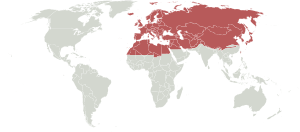Palearctic facts for kids
The Palearctic (say: Pay-lee-ARK-tik) is one of the eight main ecozones that divide the Earth's surface. Think of ecozones as huge areas with similar plants, animals, and climates.
The Palearctic is the biggest ecozone by far. It covers a massive area! This includes the land regions of Europe, most of Asia (north of the Himalayas), northern Africa, and the northern and central parts of the Arabian Peninsula.
Contents
Major Natural Areas
The Palearctic ecozone mostly has climates that are either boreal (cold, northern forests) or temperate (mild, with seasons). These areas stretch all the way across Eurasia, from western Europe to the Bering Strait.
Europe and Siberia: A Vast Region
The Euro-Siberian region is the largest natural area within the Palearctic. It changes a lot as you go north to south. In the far north of Russia and Scandinavia, you'll find cold, treeless tundra. South of that is the huge taiga, which is a massive forest of evergreen trees.
Further south from the taiga, you'll find temperate forests. These include broadleaf trees (which lose their leaves in autumn) and mixed forests (with both broadleaf and evergreen trees). This huge Euro-Siberian area shares many types of plants and animals. It's quite similar to the temperate and boreal regions of the Nearctic ecozone in North America.
Did you know that Eurasia and North America were often connected by a land bridge called the Bering land bridge? This allowed many animals, like mammals and birds, to move between the two continents. That's why they share so many similar species! Many scientists even consider the Palearctic and Nearctic to be one giant Holarctic ecozone. They also share many plant species.
The Mediterranean Basin: A Special Climate
The lands around the Mediterranean Sea in southern Europe, northern Africa, and western Asia have a unique climate. They have mild, rainy winters and hot, dry summers. This area is known as the Mediterranean basin. It's the world's largest and most diverse region with this kind of climate.
This area is a mix of forests, woodlands, and scrub (bushes and small trees). It's home to an amazing 13,000 species that are endemic. This means they are found nowhere else in the world! Because of all these unique species, Conservation International calls the Mediterranean basin one of the world's biodiversity hotspots. This means it's a very important place for protecting different kinds of life.
Sahara and Arabian Deserts: A Natural Barrier
A huge belt of deserts, including the famous Sahara desert and the Arabian desert, acts like a natural wall. It separates the Palearctic ecozone from the Afrotropic ecozone (which covers most of Africa).
These desert regions are usually considered part of the Palearctic ecozone. However, some scientists think the boundary should be where the deserts meet the Mediterranean areas to the north. Others place the boundary right through the middle of the desert.
Western and Central Asia: Mountains and Grasslands
The Caucasus mountains, located between the Black Sea and the Caspian Sea, are a very rich area. They have a great mix of evergreen, broadleaf, and mixed forests. Some parts even have temperate rain forests!
Central Asia and the Iranian plateau are mostly dry steppe grasslands and desert basins. But in the high mountains and plateaus of this region, you can find mountain forests, woodlands, and grasslands.
The lower parts of the Himalayas (around 2000–2500 meters high) form the boundary between the Palearctic and the Indomalaya ecozone (which includes parts of South and Southeast Asia).
East Asia: Ancient Forests
China, Korea, and Japan are more humid and have milder temperatures than nearby Siberia and Central Asia. These areas are home to rich temperate forests, including evergreen, broadleaf, and mixed types. Today, most of these forests are found in mountainous areas. This is because the lowlands and river basins are very crowded with people and have been turned into farms and cities.
East Asia was not affected much by the ice ages. Because of this, it kept a huge number of its ancient tree types. For example, it still has 96 percent of the tree types that existed during the Pliocene epoch (a long time ago!). Europe, on the other hand, only kept about 27 percent of its Pliocene tree types.
Images for kids
-
Frontispiece to Alfred Russel Wallace's book The Geographical Distribution of Animals
See also
 In Spanish: Paleártico para niños
In Spanish: Paleártico para niños



